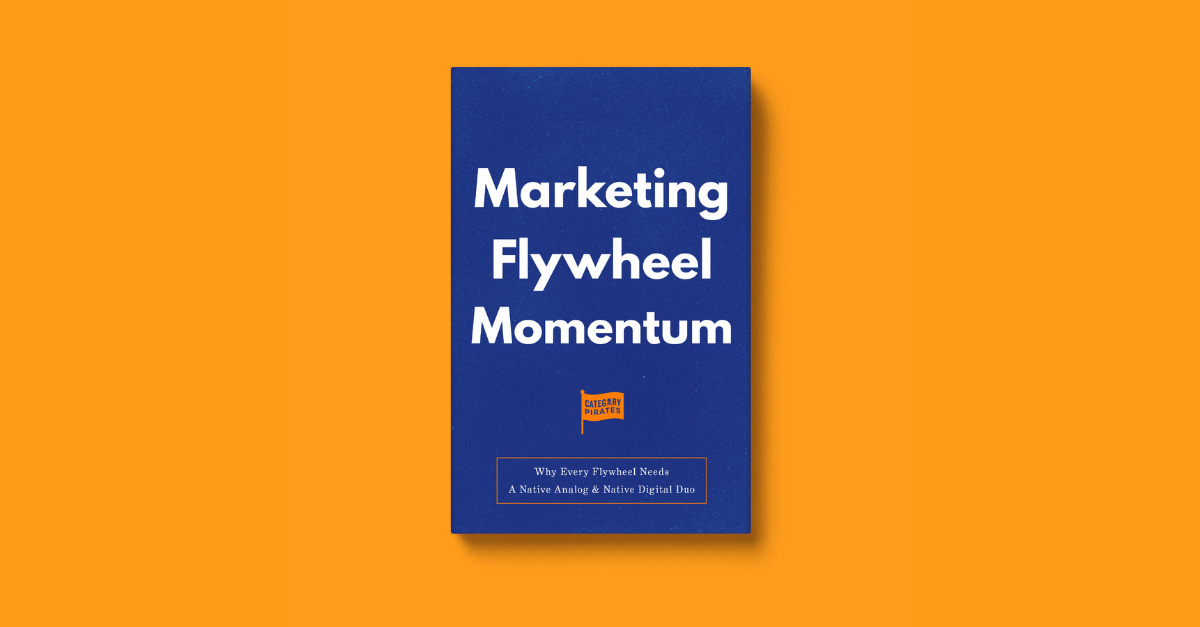Marketing Flywheel Momentum: Why Every Flywheel Needs A Native Analog & Native Digital Duo
Trying to “figure it out” alone slows everyone down.
Arrrrr! 🏴☠️ Welcome to a 🔒 subscriber-only edition 🔒 of Category Pirates. Each week, we share radically different ideas to help you design new and different categories. For more: Dive into an audiobook, listen to a category design jam session, or upgrade to a Founding subscription to ask the Pirate Eddie Bot your category design questions.
Dear Friend, Subscriber, and Category Pirate,
The Marketing Funnel Funeral is one of our most-shared mini-books.
It struck a nerve because it named the truth many marketers already felt:
“Funnels force conversion. Flywheels create conversation.”
“Funnels don’t leak leads. They hemorrhage belief.”
“Funnels are a legacy lie. Flywheels are the future.”
This matters because funnels don’t create marketing momentum. They halt it. They assume customers are disposable and dumb.
Marketing funnels make Facebook rich.
Marketing flywheels make founders rich.
That’s why we argued for a shift from funnel thinking to flywheel strategy—marketing that doesn’t just attract attention, but builds community, accelerates word of mouth, and compounds over time.
(When it came out, Gina Bianchini, the CEO of Mighty Networks, where we host our courses and communities, shared it with her entire team.)
We Pirates are proud of that mini-book, but the comments revealed we had more work to do.
So if The Marketing Funnel Funeral made you say, “Yes, I believe in flywheels!”…
Then this mini-book answers:
“How do I get my flywheel spinning?”
The marketing flywheel spins fastest when you build with a Native Analog, a Native Digital, and AI.
AI is the massive unlock that helps build your flywheel’s momentum.
But flywheels don’t run on algorithms. They run on belief. So, they need people (Supers, Partners, Bandmates) to make the machine go.
On top of an AI co-founder, you need:
A Native Analog with clarity about questions, outcomes, and signal. They bring vision with lived experience and constraints. They have a category POV and a roadmap.
A Native Digital with speed, taste, and execution instincts. They know how to build, iterate, and bring the vision to life. They have cultural fluency and creative risk.
So, how does this play out in real life?
Let us introduce you to Jack, a Native Digital who helps spin our marketing flywheel.
Jack isn’t supposed to be “the AI guy.” He’s not a software engineer. His degree is in political science. And his first job was wrangling spreadsheets inside a healthcare marketing team.
But Jack has a weird gift.
(We look for and love & weird… ‘Cause weird is often where Non-Obvious insights live.)
Jack quickly figures out how new technology works. He’s a builder who likes creating things, just to see what happens.
When Pirate Eddie met Jack, he wasn’t looking for an AI partner.
Eddie and his partner, Clint Carnell, were brought in to help scale the company Jack worked for. It aimed to drive breakthrough outcomes but had an upside-down P&L because marketing costs were way out of control. You see, the previous leadership still believed (too much) in marketing funnels. The prior funnel was full of revenue leaks. Leadership opted not to plug the holes, but pour more leads into it. Marketing costs exceeded revenue.
(Never forget: Marketing’s number one job is revenue.)
Pirates Clint and Eddie immediately cut marketing costs in half by flipping the strategy 180 degrees and raising prices by 60%. This drove significant profitable growth. But Eddie wanted to build the next-generation marketing machine.
Eddie envisioned a zero customer acquisition cost marketing flywheel—one that would both give and get in a single motion:
Give (to customers):
Problem: Customers were unsure of how to price their services.
Solution: Share national price benchmarks based on real market data.
Bonus: Make pricing strategy feel simple, not scary.
Get (for company):
Problem: Customer leads were expensive and inefficient.
Solution: Use the pricing tool to collect prospect data automatically.
Bonus: Deliver instant value and generate leads with zero ad spend.
Eddie wanted to create a pricing tool that could take messy customer data and instantly turn it into useful recommendations, emailing respondents their results within 30 seconds.
This wasn’t anyone’s job.
So Eddie pitched the idea to Jack, who had a reputation for being able to “make weird data sing.”
Jack didn’t ask for a detailed spec. He put together Google Forms, Sheets, automations, and AI. Within days, they had a working pricing analytics product. It provided real insights, delivered automatically, and was personalized to every customer who completed the survey.
The project changed the way they worked together.
Jack brought the AI experimentation, speed, and technical muscle. Eddie brought the business context, strategic frame, and user insights. AI didn’t replace either of them—it amplified what they could do together.
But most people never get this far.
Instead of finding the right bandmate, they fall into reflexive thinking traps:
“You either get AI, or you don’t. It’s a skills gap, a generation gap, or a tech fluency gap.”
This is the shallow, reflexive, lazy (BS) lie we tell ourselves when we don’t know how to build momentum.
We shrug. We blame someone’s age or background. We act like it’s a solo problem.
Native Digitals are told: “Just go learn AI on your own. Figure it out. Ship fast.”
Native Analogs are told: “You’re behind. You’re slow. You need to upskill.”
Founders and execs are told: “Hire Native Digitals who ‘get it’ and hope for the best.”
It’s an intergenerational AI-powered cluster, Chuck.
So what happens? Everyone stays in their isolated lanes, and nobody excels. Worst of all, people stop thinking about thinking.
But we’re Category Designers who don’t settle for symptom talk. We dive deeper to produce results. And we know AI is something we’re all learning, teaching, and building together in public.
In reality, this problem is a jam waiting to happen.
Native Digitals are experimenting, adapting, and building faster with AI.
But they (often) lack the business experience to know:
What is the business context that matters?
What is a legendary quantifiable business outcome?
What are the right questions to ask before I try to answer it?
Native Analogs have more business experience and proven POVs.
But they lack the technical know-how (and in some cases too much old thinking) to get an outcome via AI:
Is this truly a bespoke AI thing or an off-the-shelf automation?
Which automation or AI tech is best suited for this?
Where do I even start? Is this thing on?
This isn’t just a tech gap.
It’s more than getting over Google brain.
It’s a full-blown misfire in how generations approach creativity, collaboration, and co-creation with AI.
The challenge is that Native Analogs and Native Digitals speak different creative languages.
One vibes first. The other plans first.
One values speed. The other values accuracy.
One values transparency. The other values privacy.
One grew up puking. The other grew up perfecting.
When Native Digitals and Native Analogs fail to work together, chaos happens.
 Tiktok failed to load.
Tiktok failed to load.Enable 3rd party cookies or use another browser
But when both groups collaborate, exponential output emerges.
Native Digitals puke, play, and produce.
Native Analogs refine, reframe, and redirect.
And AI becomes the amplifier for both.
Too many people struggle to activate a self-sustaining, AI-powered Marketing Flywheel because they’re trying to build it alone. But with the right bandmates—and AI as your amplifier—it doesn’t just spin. It sings.
In The Marketing Funnel Funeral, we made the case for moving from short-term attention capture to long-term community and word-of-mouth. Now, your goal is to make that flywheel spin in the AI era. Not alone. But in duets, bands, and crews, where every jam becomes a training loop for your flywheel.
This isn’t content marketing. It’s category compounding, accelerated by AI.
Let’s dive in.
The Flywheel Momentum Framework: 3 Steps To Accelerate Word Of Mouth With Superconsumers
Most marketing frameworks tell you to "attract" more customers.
That’s fine, but it misses the point.
The goal is to accelerate word-of-mouth.
(WOM is, and always will be, the most powerful form of marketing.)
The marketing flywheel isn’t a funnel with a conversion goal. It’s a compounding engine of belief and word of mouth, powered by your Supers and tuned by AI.
So, how do you get people talking?
Here’s the 3-step framework we’ve landed on—after working on it with interns, Founding subscribers, and the Pirate Eddie Bot.





